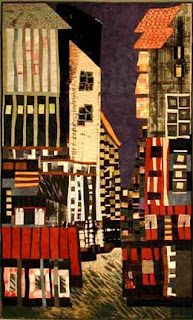
What d’you do with all the quilts you’ve made that are getting a big long in the tooth and are totally unloved and unsold?
Here are some possibilities:
- offer them to your children – after all, any discerning and loving child will be bound to want Momma’s art work on the wall – right? If you include the poles, and the nails and a hammer and a step ladder…they may even take them!
- try selling them for knock down prices at the local guild’s annual quilt show – you can always add a few beads or bows or even a blue ribbon or two to try to increase their desirability
- Fold neatly into a dog or cat bed – these can always be rescued later and given a quick wash should a customer finally appear!
- offer to your minister – it helps if you write a few messages here and there on the piece “with best wishes from all your parishioners” or something of that sort.

- Cut up into smaller pieces, splash with guache or even a quick spray with car paint, or that matt black you did the barbecue with last week, and frame in little gold frames and sell at the next art fair.
- cut up into pot holders – here’s a touch Martha would approve of: stitch differently coloured ribbon round each one and make a loop – hang as a triptych on your kitchen wall and decorate a little apron to match for yourself. If you want to complete the vision, then a waitress cap with ribbons will make hubby glow when he comes in after a hard day’s work.
- cut the quilt into a rectangle and a circle, then assemble as a bog roll cover. Sew kewt!
- give to the salvation army writing down on the form “rare art work valued at $99, excellent condition”
- when looking after the neighbour’s cats when they’re away, hang the piece over their mantelpiece – they’ll be so thrilled they’ll buy 3 more from you instantly.

- cut up into cute little vests for yourself and 3 friends to wear at the next IQA show – you’ll start a trend! (or maybe end one!)
- Seventeen of them glued together will make a nice footstool for your feet.
- Give one to your husband to hang over the television - so much more interesting than sport.
- offer one to your dentist in lieu of his normal fee – after all, it will look good on the boat!
- Don a uniform and a tool belt, with a ladder over your shoulder, hang them in various public buildings around your town. Everyone will be so pleased to have real (rather than Hallmark) art!

- Send them to Project Runway – see if Tim can “make them work”!
- Announce on your blog: OK you lot, I’m not making ONE more quilt until this lot is Sold!!!
- Set fire to the lot!
And, if you have been….thanks for reading – and good luck with the backlog!!!

































































